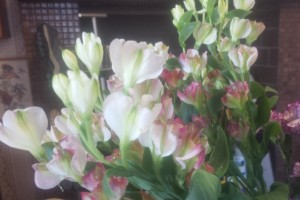 I blame my daughter for bringing Charmelia into the house. We have been trading a nasty cold back and forth for weeks, alternating stages so that one of us always has a congested head and the other a hacking cough. Last week, she was temporarily in the recovery stage of her particular cold and went out seeking something to make us feel better. Instead of bringing home nasal spray, she brought home Charmelia.
I blame my daughter for bringing Charmelia into the house. We have been trading a nasty cold back and forth for weeks, alternating stages so that one of us always has a congested head and the other a hacking cough. Last week, she was temporarily in the recovery stage of her particular cold and went out seeking something to make us feel better. Instead of bringing home nasal spray, she brought home Charmelia.
Charmelia is neither an over-the-counter remedy nor a variety of reptile. It is a flower, available at the grocery store. Though it did nothing for my congestion, it made me feel better all the same. It also made curious about its origins.
Flower marketers these days typically hang a tag on cut stems that tells you nothing except the particular flower’s trade name. Charmelia® is the registered trade name in this case. Each erect, branching stem of our cold-cure Charmelia was surmounted by clusters of six-petaled flowers that opened from pale green buds to reveal pink and white petals with greenish, lightly speckled centers. The petal edges were slightly curled back and the elongated leaves were a healthy shade of medium green. The collection of about five stems looked fresh and spring-like in a tall vase. I think the scent was minimal, but my perception was probably altered by the fact that my nose was not working.
Charmelia looked to me like an altstroemeria or Peruvian lily, but, of course, I had to do a little research. Fortunately, in addition to being a decent distraction from the common cold, Charmelia is one of the current darlings of the cut flower trade. Information was easy to find.
Peruvian lilies are not members of the lily family, but they are native to Peru and parts of South America. About 50 species exist, though only two are commercially cultivated, mostly for the cut flower trade. I have no doubt that Charmelia is the offspring of one or both of those species. Breeding efforts took place in the Netherlands, a longtime hub of all things horticultural. The Dutch began sending alstroemerias to the American cut flower market in the 1970’s. At the time, the range of colors—reds, yellows, oranges, creams and pale blues—and the slightly exotic look of the flowers, made them a hit with florists. Sometimes the petals are also accented with pale maroon speckles, like Charmelia’s, or more dramatic spots or stripes. Alstroemeria also has another key trait, long vase life, which makes it a commercial winner.
But things are never static in international commerce and the “plain old” alstroemeria was so popular that it became something of a floral cliché, eventually reduced to displaying its charms in all kinds of down- market settings. Breeders like floral clichés about as much as they like whitefly outbreaks in the greenhouse, so they are always working to improve workhorse flowers. This is why Charmelia, or more properly the Charmelia line of alstromeria, was created. The stems my daughter brought home are most likely the ‘Bridesmaid’ variety, so named because of its suitability for wedding bouquets and arrangements. Another variety in the line is Charmelia ‘White’, presumably with white blooms and the same stem and flower configuration.
Charmelia alstroemeria is not available to gardeners, so your best bet is to make your way to the nearest florist or grocery story plant department and pick up a few stems to brighten the post-holiday indoor landscape.
I have tried a different variety of alstroemeria once in my garden, but the plant failed and I have not made a second attempt. Perhaps Charmelia will convince me to try again, especially if this cold resolves itself before July. American catalog vendors sell several varieties, all of which are hardy to USDA zone 7b or even warmer. Perhaps more important, the commercially available alstroemeria can withstand minimum winter temperatures of zero degrees Fahrenheit. The closest in appearance to Charmelia is probably ‘Koice’, a Dutch-bred variety with white flowers that shade to light peach, flecked with cinnamon dots. It grows about 18 inches tall and flowers repeatedly over the course of the growing season, if it is happily sited in a sunny to very lightly shaded position with good drainage. Grow it successfully and you may attract the hummingbirds that pollinate alstroemeria, not to mention the possibility of clipping summer bouquets that will rival the Charmelia stems you can buy in the winter.
If you are looking for a good alstroemeria to brighten your mixed border or large container, try Plant Delights Nursery, 9241 Sauls Road, Raleigh, NC 27603 (919) 772-4794, www.plantdelights.com. Print catalog, $7.00.
